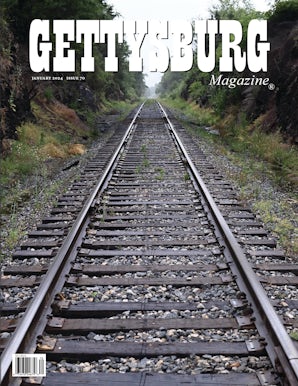
ISSN 2372-6059
eISSN 2377-0783
Written for both professional and amateur historians, Gettysburg Magazine has been publishing engaging and highly readable works of original scholarship concerning the battle and campaign of Gettysburg since 1989. Each issue presents peer-reviewed research into the strategies, the controversies, the participants, the witnesses, and the events leading up to and following the battle. Features include personal essays, historical and contemporary photography from the site, and maps that allow readers to more fully visualize the events of those critical three days in American history.
Issue 70 (December 2023)
Contents
Introduction
Articles
“They Called Each Other Comrades”: The Story of Rufus Dawes, William Murphy, and the Capture of the Flag of the 2nd Mississippi
Steve Magnusen
My Beloved Arabella
Andrea M. Quinn
“My Own Movement and On My Own Responsibility”: The Saga of Lafayette McLaws’s Commentary on Longstreet at Gettysburg
Cory M. Pfarr
“The conduct of my men and officers was in all respects creditable”
Phillip Muskett
The London Times Reports “The Battles
of Gettysburg”
Thomas J. Ryan
“For Honorable Living and Hopeful Dying”: Union Chaplains at the Battle of Gettysburg
Nancy Jill Hale
On Campaign with Civil War Trails: Union Mills
Chris Brown
A Michigan Cavalryman: The Life and Untimely Death of Major Noah Henry Ferry, 5th Michigan Cavalry
Eric J. Wittenberg
If You Want to Go: Pictures of Where It Happened . . . And Standing in the Tracks of History
Sonny Fulks
Statement of Publishing Ethics
Manuscripts
The Gettysburg Magazine publishes articles, edited documents, human interest stories, and book reviews of interest to scholars, history buffs, and members of the general public interested in the Gettysburg Campaign, the Gettysburg Address, the Gettysburg National Military Park, and the various personalities and controversies associated with these formative events. Scholarship from any discipline in the humanities and social sciences is welcome. Manuscripts may be submitted for review by the Editorial Board via e-mail attachments to the editor. Submissions should be in Microsoft Word or a compatible program. Illustrations are encouraged and should be submitted in electronic form scanned at a minimum of 300 dpi (dots-per-inch). Copyright laws require that the author receive written permission for illustrations that are not in the public domain. Electronic copies made with cell phone cameras or other devices with low resolution will not reproduce well in print. The style of submissions should follow the latest edition of the Chicago Manual of Style. Sources should be fully identified in footnotes or endnotes using the footnote/endnote function in Word. The magazine publishes in January and July of each year, although there are no specific deadlines for submission. Accepted manuscripts are normally published in the next available issue. Questions regarding submissions may be directed to the editor at dwelch1863@gmail.com.
Trending Articles - Summer 2021
"The Angel of the Wheatfield" (Iss. 52, 2015)
"The Discovery of Babcock Rock" (Iss. 56, 2017)
"Of Cupolas and Sharpshooters: Major General John Fulton Reynolds and Popular Gettysburg Myths" (Iss. 59, 2018)
"Serving the Guns in Thompson's Battery" (Iss. 59, 2018)
"The Emanuel Harman Farm: Gettysburg’s Unknown Battlefield" (Iss. 54, 2016)
Click the link above to view this journal's advertising rates & options!
Libraries face a dilemma: the number of books, journals, and other information resources available to offer to their patrons is growing faster than their acquisitions budgets. Decisions about which new materials to add in a given year are influenced by a number of factors, not the least of which are whether they are aware of the existence of a resource and the value that resource would bring to those who rely on the library. Librarians often appreciate the input of users in gathering the information they need to make those evaluations. There is no one right way to share information about a particular journal with a library. Some institutions have formal procedures for submitting acquisition requests, others rely on regular communication between subject area librarians and the departments they serve, and some have no specifically defined method. You are in the best position to determine the most appropriate method for approaching your library with a request for the addition of a journal to its collection. However, we have developed a library recommendation form as one tool you can use to provide your library with relevant information. The form contains basic information about the journal: a description, its print and electronic ISSNs, frequency of publication, pricing, print and electronic options, and ordering information. It also includes a few questions for you to complete that address your evaluation of the journal's value. If you choose to use the form, fill it out then send it to the appropriate individual at your library. Do not return it to the University of Nebraska Press.